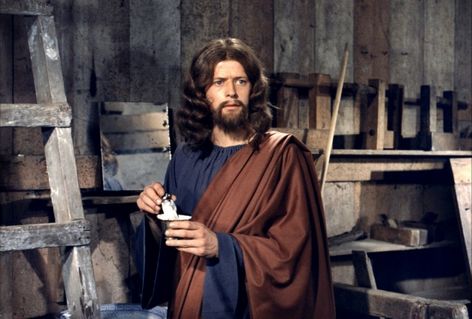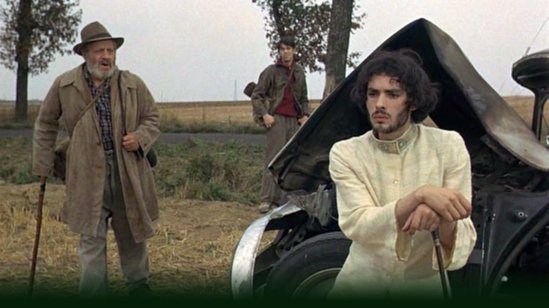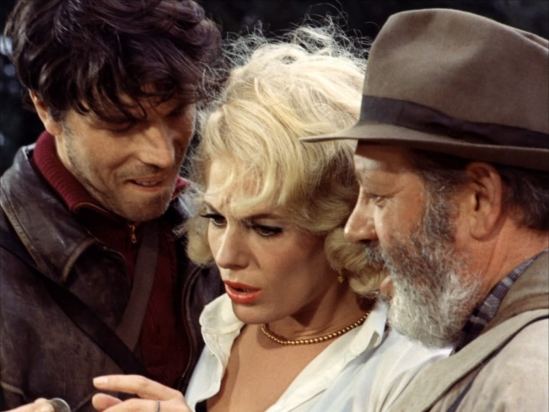Luis Buñuel’s films are of such gracious curmudgeonly humor, intelligence and narrative creativity that it’s easy to mistake his lesser efforts for ‘disappointments.’ It’s a trap I’m afraid I caught myself falling into upon viewing his two late-sixties works, The Milky Way and Tristana. Wonderful films like Nazarin, Viridiana, The Exterminating Angel and Belle De Jour are quite singular creations; thoughtfully rigorous narratives expressed clearly and efficiently, with little patience for manipulative sentiment or lesson-learned false earnestness. I found The Milky Way and Tristana to be a little re-hashed, a little formulaic in their individual ways – more interesting and admirable than genuinely provocative or entertaining. But, honestly, we’re still working in a pretty rare league of filmed storytelling here; not only did Buñuel (born in 1900) make these films while entering his seventies, but the three films that followed these are flat-out masterpieces.
The Milky Way (La Voie Lactée) (France, 1969) is similar to 1965’s Simon Of The Desert – an entertaining survey and critique of Christian beliefs and dogma. Buñuel collaborates here with Jean-Claude Carrière to create an archetypical road movie. The film follows two “kings of the road,” an older, grizzled Pierre (Paul Frankeur) and his young and skeptical traveling pal Jean (Laurent Terzieff), whom are making the traditional humble pilgrimage from central France to the Spanish city of Santiago de Compostela, where the holy remains of St. James are allegedly preserved. But they’re not going for their spiritual health or historical edification – they’re looking to make some money, begging for alms and taking advantage of the tourist trade there. The film clearly begins in the motorized present day, but as our pilgrims make their picaresque progress, they encounter a variety of characters and situations seemingly transplanted from different periods of history.

Bernard Verley in “The Milky Way.” credit: cinema-francais.fr
Episodically, Buñuel and Carrière explore six major tenets of Christianity, and the ‘heresies’ thereof that arose in opposition: the Eucharist – communion and transubstantiation (the wine and host/wafer becoming the blood and body of Christ); the distinction between Good and Evil, extrapolated as spiritual/physical, the soul and the body, subjective and objective; the dual nature of Christ as both human man and divine being; the concept of the Trinity – Father, Son and Holy Ghost (or Holy Spirit); the conflict between Grace and Freedom, and the assertion or sublimation of Free Will; and the mystery of the nature of The Virgin Mary. But, of course, there’s nothing doctrinaire about Buñuel’s presentations – an explanation of transubstantiation, and a dismissal of those who doubt, is delivered by a mischievous priest who ends up being apprehended by the white-coated attendants from the hospital he escaped – again. The heretic bishop Priscillian, addressing a small crowd of medieval acolytes, explains that our bodies are the creation of the Devil – only our souls are divine – which, based on those priorities, leads to a medieval acolyte orgy. The snooty maître d’ at an elegant provincial restaurant is happy to extol the teachings of Jesus, the man and the God, to his fellow workers, while giving the boot to Pierre and Jean’s humble request for scraps. At one point we even leave our two travelers and follow the other adventures of two young Protestant students (Denis Manuel and Daniel Pilon), heckling a bishop over the Trinity, exchanging identities with two hunters in the woods, and receiving seemingly mystical visitations in the woods and within their hotel rooms. Early in the film, a mysterious caped figure instructs Pierre and Jean to have their way with a whore, who will bear them children. As the film concludes, our travelers are indeed waylaid by the Whore of Babylon (Delphine Seyrig), who expresses her wish to have their children, and their destination is quickly forgotten. And peppered amongst these instructional chapters are appearances and observations from the Marquis de Sade, a persuasive lightning-bolt, a Spanish inquisitor, the Virgin Mary, and Jesus himself, hangin’ with his buds and casually dropping miracles here and there, with varying degrees of success..

Paul Frankeur, Laurent Terzieff and Pierre Clementi in ‘The Milky Way.” credit: fr.film-cine.com
Buñuel would employ this omnibus / series of satirical sketches format in his later films as well; after the explosion of sketch-comedy shows like Monty Python and SCTV and The Young Ones, etc., The Milky Way doesn’t feel like a precursor and model for much of that, even though it is, clearly. At one point, a Jesuit and a Jansenist actually take swords up to duel over the nature of Grace and Predetermination – they shout religious academic arguments at each other between parries and thrusts – and one could easily picture Eric Idle and Graham Chapman in their places.

Laurent Terzieff, Delphine Seyrig and Paul Frankeur in “The Milky Way.” credit: kebekmac.blogspot.com
I vastly prefer when Buñuel illustrates his rich views of fickle human nature and institutionalized belief systems within a larger narrative (Nazarin, Viridiana, Diary Of A Chambermaid) rather than creating a linear plot that simply becomes the delivery device for the overt points he wants to make. Simon Of The Desert wasn’t supposed to be as short as it ended up being, but its brevity works to the film’s advantage; just as we start to feel a little lectured-to, things wrap up. With The Milky Way, Buñuel got to spend more time in the candy store, and some of the segments overstay their welcome – a lengthy scene at a rural girls’ school picnic is oddly humorless, and weirdly (but thankfully) interrupted by Jean’s own reverie of a group of armed anarchists assassinating the Pope. Later, a friendly Spanish priest goes on and on and on about the Virgin Mary, relating a fairly interesting miracle story at first, and then intrusively prattling on from the opposite side of closed doors after everyone else has called it a night. Buñuel delights in exposing the ulterior motives of these self-interested, self-promoting clerics, but it all feels a bit overindulged.
So I was looking forward to seeing Buñuel’s Tristana (France, 1970), another adaptation of a novel by Benito Pérez Galdós, whom had given us Nazarin and Viridiana. It tells the story of Don Lope (Fernando Rey), a wealthy Spanish nobleman who becomes the guardian of Tristana (Catherine Deneuve), a young girl whose widowed mother dies unexpectedly. Generally respected by the clubby male Toledo community, he’s a profligate roué – a trust-fund baby – who wastes little time in having his way with the passive and deferential orphan girl under the guise of fatherly propriety, and later as husband’s prerogative. “Your mother was very good, but not so very intelligent… You never enjoyed your father’s wealth – he lost it all when you were very young.” But as Tristana grows and enriches herself under the higher-class milieu that the Don has provided her, she develops an independent streak and ultimately chooses to run off with the artist Don Horatio (Franco Nero). But Don Lope has tutored her well in self-indulgent non-commitment, whether she’s aware of it or not, and her co-dependence is profound – she and the artist never marry, and when a nasty tumor from a mysterious disease (am I out of line to suspect syphilis here?) leads to the amputation of her leg, she returns to the house of Don Lope to languish and, eventually, take revenge on him.

Fernando Rey and Catherine Deneuve in “Tristana.” credit: 50anosdefilmes.com.br
Catherine Deneuve frequently cites Tristana as one of her most satisfying performances, and it’s easy to see why. Tristana’s transformation – from doe-eyed orphan schoolgirl to She Who Must Be Served, dressed in black, strutting out of her perfunctory church-marriage to Don Lope with cane and prosthetic leg, and attended to in her wheelchair by the housekeeper’s deaf-mute son – is the best part of the film. The rest is a surprisingly conventional melodrama, although there are some hints of Buñuel’s usual stew of psychology and fetish. The very first scene introduces us to Saturna (Lola Gaos, excellent here), Don Lope’s housekeeper, taking Tristana out for a walk to get her out of the house (and enliven her near-cloistered life under Don Lope), but stopping off to check on her deaf-mute son, Saturno (Jesús Fernández), who continually acts out anger at his school. (Saturna and Saturno – hard not to think of Goya here…). Even at this early stage, only minutes into the film, we have a glimpse of Tristana’s bond with Saturno as a fellow outsider, and as a potential partner in crime – after the headmaster scolds him for getting into a fight during a football match, she gives him an apple. Uncharacteristically, Buñuel opts for outright symbolism throughout, rather than his more ambiguous but resonant surrealist perspective. Tristana has a recurring dream about Don Lope’s decapitated head acting as the clapper of a giant church bell, but beyond that touch of absurdity it’s all, disappointingly, Freud and mythology.

Catherine Deneuve in “Tristana.” credit: cinedivergente.com
Later on, The Milky Way became the first film of what Buñuel and Carrière eventually fashioned into a trilogy (The Discreet Charm Of The Bourgeoisie and The Phantom Of Liberty followed, and both relied on that same format of a series of disparate episodes across a linear narrative). Discreet Charm involves a group of wealthy people trying to have dinner together. Phantom seems like a random series of dream sketches, but is unified by Buñuel and Carrière’s observation of how short-sighted the characters are, and how they all seem to exist in a self-serving, vacuum-sealed eternal present, despite the historical and philosophical signifiers surrounding them throughout. It’s the most surreal of his later films – rough going for the uninitiated, but quite wonderful.
As for Tristana, I’ve seen suggestions elsewhere that it’s actually a good place to start if you’ve never seen a Buñuel film, and I’d agree with that. Just about any of his other 60s films are much better, but Buñuel always serves Pérez Galdós well, and vice-versa. And it’s one of my favorite Deneuve performances. While not as conceptually rigorous as the others, Tristana is a good example of what I’d call Buñuel’s gracious misanthropy – he’s unstinting in showing us the blithering follies we consign ourselves to socially, morally and philosophically, but he almost always evinces empathy as well. “There but for the grace of God…?”
Pingback: Movies – The Delphine Seyrig Project – Daughters Of Darkness and others. | Periscope In The Bathtub